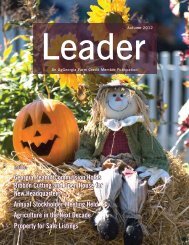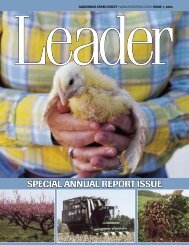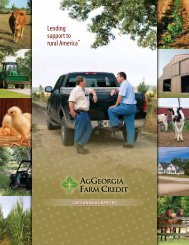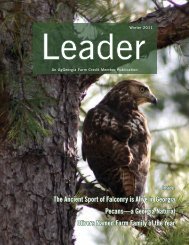Special Annual Report Issue - AgGeorgia Farm Credit
Special Annual Report Issue - AgGeorgia Farm Credit
Special Annual Report Issue - AgGeorgia Farm Credit
- No tags were found...
Create successful ePaper yourself
Turn your PDF publications into a flip-book with our unique Google optimized e-Paper software.
Since it is a non-perishable crop, cotton storedin a government-approved warehouse provides asecure basis for a monetary loan.is then air conveyed to gin stands whererevolving circular saws pull the lint throughclosely spaced ribs that prevent the seedfrom passing through. The lint is removedfrom the saw teeth by air blasts or rotatingbrushes, and then compressed intobales weighing approximately 500 pounds.Cotton is then moved to a warehouse forstorage until it is shipped to a textile millfor use. A typical gin will process about 12bales per hour, while some of today’s moremodern gins may process as many as 60bales an hour.ClassingAfter the lint is baled at the gin,samples taken from each bale are classedaccording to fiber strength, length, lengthuniformity, color, non-fiber content andfineness using high volume instrumentation(HVI) and the aid of an expert calleda Classer. Scientific quality control checksare made periodically to ensure that instrumentand Classer accuracy is maintained.Cotton of a given variety producesfibers of approximately the same length.Since the fibers may vary within a bale,length uniformity allows a determinationof the variability within that bale. Otherquality factors also are important. Thefiber’s fineness is important for determiningthe type of yarns that can be made from thefiber—the finer the cotton fibers, the finerthe yarns. Color or brightness of the fibersalso is important.Cotton that is very white generally isof higher value than cottons whose colormay have yellowed with exposure to elementsbefore harvesting. Cotton, beinga biological product, typically containsparticles of cotton leaves called trash. Theamount of trash also influences the cotton’svalue since the textile mill must removetrash before processing. The fiber’s strengthalso is an important measurement that ultimatelyinfluences the fabrics made fromthese fibers. The U.S. Department of Agriculture(USDA) establishes classing standardsin cooperation with the entire cottonindustry.MarketingCotton is ready for sale after instrumentclassing establishes the qualityparameters for each bale. The marketing ofcotton is a complex operation that includesall transactions involving buying, selling orreselling from the time the cotton is ginneduntil it reaches the textile mill. Growersusually sell their cotton to a local buyeror merchant after it has been ginned andbaled, but if they decide against immediatesale they can store it and borrow moneyagainst it. Since it is a non-perishable crop,cotton stored in a government-approvedwarehouse provides a secure basis for amonetary loan.CottonseedCotton actually is two crops, fiber andseed. About one-third of the cottonseedproduced from a typical crop is crushedfor oil and meal used in food products andin livestock and poultry feed. For each 100pounds of fiber produced by the cottonplant, it also produces about 162 pounds ofcottonseed.Approximately 5 percent of the totalseed crop is reserved for planting; theremainder is used for feeding as wholeseeds or as raw material for the cottonseedprocessing industry. After being separatedfrom the lint at the gin, the cotton’s seed istransported to a cottonseed crushing mill.There it is cleaned and conveyed to delintingmachines which, operating on the sameprinciple as a gin, remove the remainingshort fibers which are known as linters. Thelinters go through additional processingsteps before being made into a wide varietyAggeorgia.19.Winter 2007










